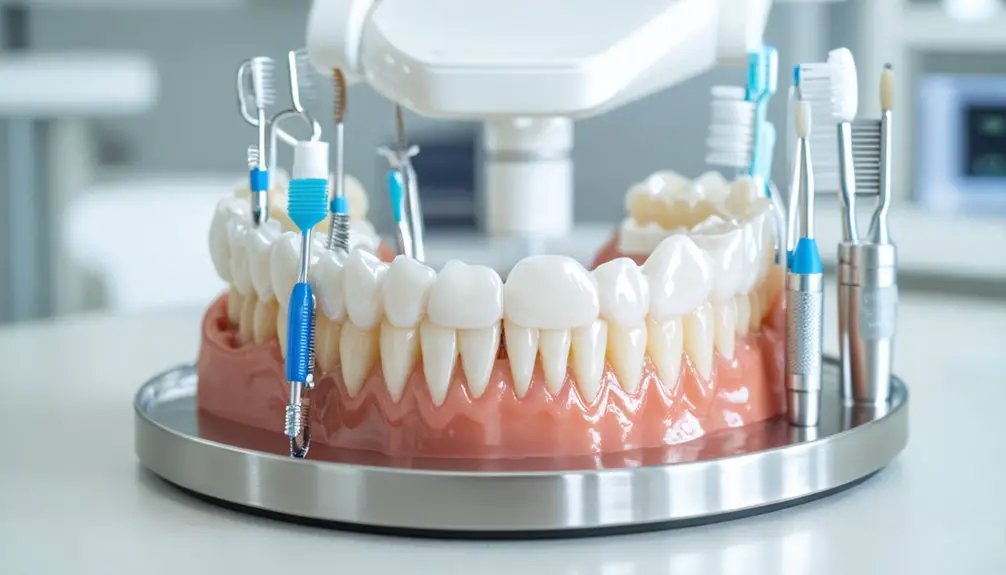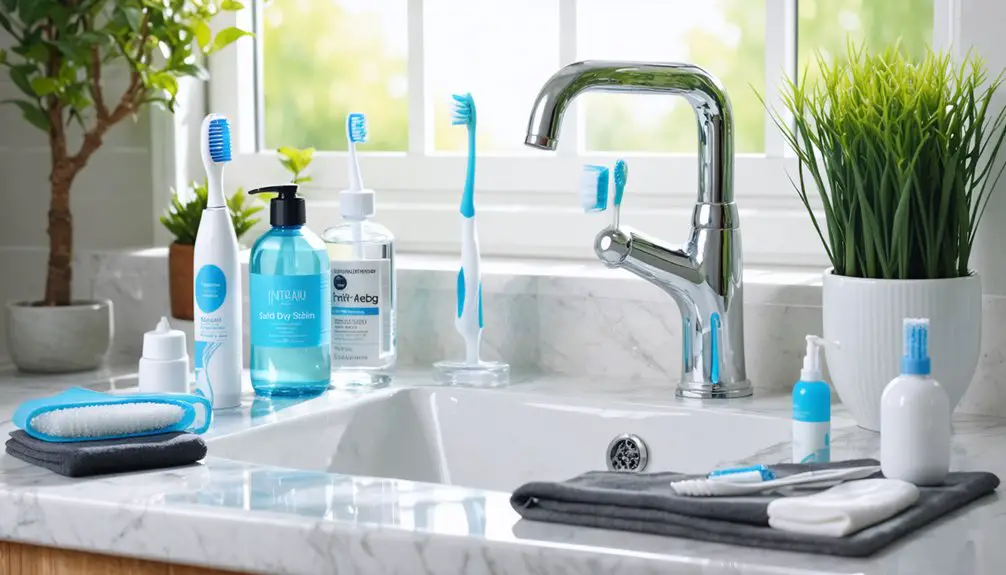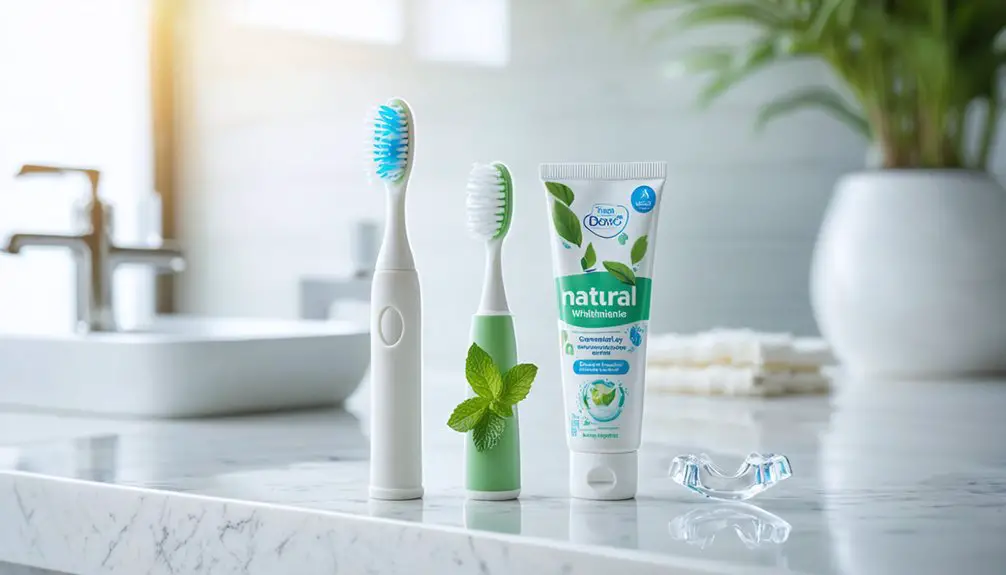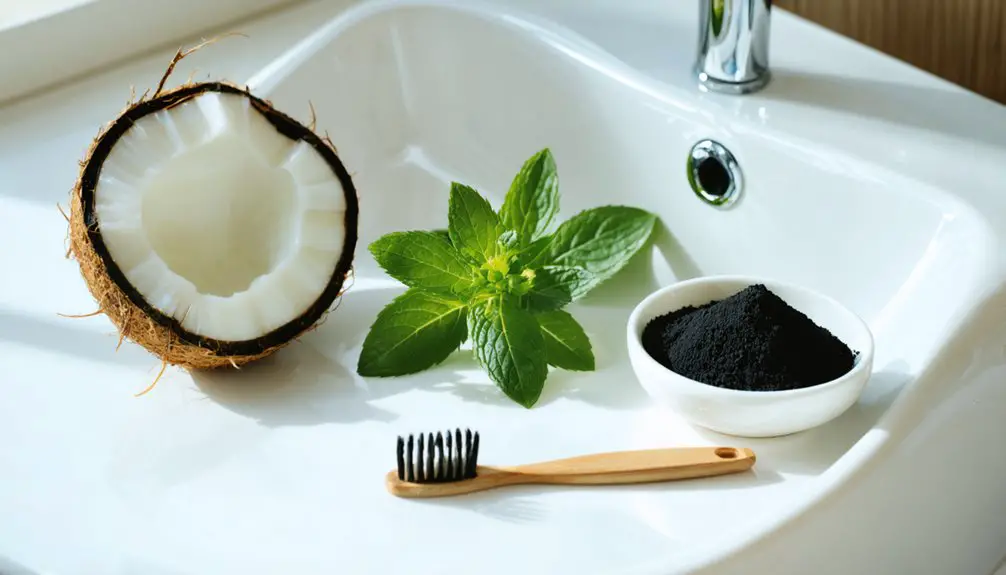While whitening with braces, you’ll need to prioritize professional guidance and careful timing. Wait at least one month post-braces removal, maintain rigorous oral hygiene with specialized tools, and avoid staining foods and beverages. Use ADA-approved whitening products, schedule regular dental cleanings, and protect your enamel with fluoride treatments. Your orthodontist should monitor the process to prevent sensitivity and guarantee even results. Understanding these essential precautions will help you achieve the bright, uniform smile you desire.
Key Takeaways
- Consult your orthodontist before starting any whitening treatment to ensure it’s safe and appropriate during your braces treatment.
- Avoid home whitening kits while wearing braces, as they can result in uneven coloring when brackets are removed.
- Use whitening toothpaste specifically designed for braces wearers to maintain consistent color and protect orthodontic appliances.
- Wait at least 30 days after braces removal before professional whitening treatments to allow teeth stabilization and reduce sensitivity.
- Choose non-abrasive, fluoride-rich whitening products to protect both your enamel and orthodontic hardware during treatment.
Wait Until After Braces Removal for Best Results
While many patients are enthusiastic to whiten their teeth immediately after braces removal, dental professionals strongly recommend waiting at least one month before beginning any whitening treatments.
This critical whitening timing allows your teeth to stabilize in their new positions and reduces sensitivity risks.
During the post-braces healing period, your teeth need time to adjust as the enamel stability improves.
Giving your teeth adequate healing time after braces allows the enamel to restabilize, ensuring long-term dental health and strength.
Any microdamage or irritation from bracket removal must heal completely before applying whitening agents.
You’ll achieve better absorption and more uniform results by waiting, as temporary enamel conditions can interfere with even whitening distribution.
Professional treatment ensures your teeth receive specialized gels and equipment that minimize discomfort during the whitening process.
Up to 50% of patients develop white spots from decalcification during orthodontic treatment, making the waiting period essential for proper assessment.
Consult your orthodontist or dentist to determine the ideal time to start whitening based on your specific oral health status and treatment completion.
They’ll assess your teeth’s readiness and recommend the most effective approach.
Practice Rigorous Daily Oral Hygiene
You’ll need to brush thoroughly after every meal using both a soft-bristle toothbrush and specialized orthodontic cleaning tools to prevent staining around your braces.
Fluoride toothpaste is essential during orthodontic treatment to protect enamel and minimize the risk of white spots developing on teeth.
Incorporate interproximal brushes and water flossers to access tight spaces between brackets and wires where standard brushes can’t reach effectively.
Clean several times daily after consuming sugary or acidic foods and beverages to prevent staining and discoloration.
Maintaining regular professional cleanings during your orthodontic treatment guarantees thorough plaque removal and helps prevent long-term discoloration issues.
Brush After Every Meal
Maintaining rigorous oral hygiene becomes essential when wearing braces, particularly through consistent brushing after every meal.
You’ll need to employ proper brushing techniques using a soft-bristled toothbrush and fluoride toothpaste for effective plaque removal around brackets and wires.
Dedicate at least two minutes to brush all tooth surfaces, adjusting your brush angle to reach under wires and along the gumline. If you’ve consumed acidic foods, wait 30 minutes before brushing to protect your enamel.
Position your toothbrush at a 45-degree angle against your gums for optimal cleaning effectiveness.
While time management can be challenging, immediate removal of trapped food particles prevents rapid plaque buildup and reduces the risk of white spots, cavities, and gum inflammation. Using an interdental brush helps reach difficult areas between brackets that regular brushing might miss.
After brushing, inspect your braces in a mirror to verify you’ve removed all debris, supporting successful orthodontic treatment and maintaining peak oral health.
Use Specialty Cleaning Tools
Three essential specialty cleaning tools form the foundation of proper oral hygiene with braces: interdental brushes, water flossers, and orthodontic-specific electric toothbrushes.
Interdental brushes effectively remove plaque and food particles between teeth and around brackets, while water flossers reach difficult areas traditional floss can’t access. Soft-bristled brushes are crucial for protecting your teeth and gums while maintaining whiteness during orthodontic treatment.
You’ll achieve superior cleaning results by incorporating these specialized tools into your daily routine. Use interdental brushes to clean between brackets and under wires, and direct water flossers at a 90-degree angle to flush out debris from hard-to-reach spaces.
Choose an electric toothbrush with an orthodontic head designed specifically for braces, as these bristles accommodate the brackets and wires while providing thorough cleaning action. The pulsating water action from water flossers is particularly effective at removing debris below the gumline while being gentle on sensitive tissues.
These tools work together to prevent staining and maintain excellent oral hygiene throughout your orthodontic treatment.
Follow Professional Cleaning Schedule
Regular professional cleanings and rigorous daily oral hygiene form the cornerstone of successful teeth whitening with braces.
Schedule appointments with your hygienist at least every six months to remove stubborn plaque and tartar that accumulate around brackets and wires. These cleanings are essential, as hygienist tools can access areas unreachable through regular brushing and flossing.
Your cleaning frequency directly impacts the potential success of future whitening treatments.
Professional cleanings allow your dental team to evaluate your gum health and identify any enamel concerns before they become serious issues. Since braces create extra challenges for oral care, using proper brushing techniques is crucial for preventing stains. Maintaining fluoride-based toothpaste use between cleanings helps strengthen tooth enamel and protect against sensitivity. By maintaining this schedule, you’ll reduce the risk of white spots and surface stains that could affect uniform whitening results.
Additionally, these visits help prepare your teeth for safe whitening procedures once your braces are removed.
Choose the Right Tools for Cleaning
You’ll need both specialized tools and proper technique to maintain clean braces, with electric toothbrushes offering superior plaque removal compared to manual ones when fitted with orthodontic brush heads.
For effective flossing, you’ll require specific tools like floss threaders, superfloss, or water flossers to navigate around brackets and wires.
These specialized cleaning implements work together as an integrated system to help prevent staining and maintain oral health while wearing braces.
Electric Vs Manual Brushes
While both manual and electric toothbrushes can effectively clean teeth with braces, clinical studies demonstrate that electric models deliver superior plaque removal rates of 11-21% when compared to manual brushing.
Electric toothbrushes’ oscillating heads excel at accessing difficult-to-reach areas around brackets and wires, requiring less precise technique than manual brushing.
You’ll benefit from built-in features like two-minute timers, quadrant alerts, and pressure sensors that protect your braces and gums.
The compact, round brush heads navigate orthodontic components efficiently, while multiple cleaning modes accommodate sensitive areas.
Though electric toothbrushes cost more initially and require regular maintenance, their enhanced cleaning capabilities and user-friendly features make them particularly valuable for orthodontic patients who need thorough, consistent cleaning routines.
Specialty Floss Tools Required
Selecting appropriate flossing tools becomes essential for maintaining ideal oral hygiene with braces. You’ll need specialized tools to effectively clean around brackets and wires, including floss threaders that guide dental floss beneath orthodontic wires.
Combine these with wax-coated floss to reduce shredding and enhance comfort during cleaning. Incorporate interdental brushes into your flossing techniques to reach areas between teeth and around brackets where traditional tools can’t access.
Consider using orthodontic-specific floss picks with C-shaped ends for easier maneuvering, and supplement your routine with a water flosser to flush out debris. For best results, select PTFE or waxed floss paired with threaders, ensuring thorough cleaning while protecting your orthodontic investment and maintaining gum health throughout treatment.
Monitor Your Diet and Drinking Habits

Maintaining proper dietary habits plays a critical role in successful teeth whitening while wearing braces.
Good dietary choices are essential for achieving optimal whitening results during orthodontic treatment with braces.
You’ll need to make strategic dietary adjustments to protect your enamel and prevent staining. Limit sugary and acidic foods, as they fuel bacteria that can cause white spot lesions – a common issue affecting about 50% of orthodontic patients.
Your drinking choices greatly impact whitening success. Avoid dark beverages like coffee, tea, red wine, and dark juices that contain staining compounds.
Instead, opt for water frequently throughout the day to rinse away acids and food particles. Choose teeth-friendly foods like crunchy fruits, vegetables, and dairy products that provide natural cleaning action and enamel-strengthening minerals.
When consuming staining substances, rinse immediately with water to minimize pigment adherence and acid exposure.
Schedule Regular Professional Cleanings
Beyond monitoring your diet, scheduling regular professional cleanings stands as a cornerstone of successful teeth whitening with braces.
You’ll need cleanings every 3-4 months, as your orthodontic hardware creates additional surfaces where plaque can accumulate. These professional sessions utilize specialized tools designed specifically for cleaning around brackets and wires without causing damage.
Regular cleanings help prevent white spot lesions and guarantee uniform whitening results by maintaining consistent plaque control throughout your treatment.
Your dental team will use ultrasonic scalers and fine hand instruments to remove tartar buildup, followed by thorough polishing to eliminate surface stains.
They’ll also monitor your oral health, checking for any signs of decay or gum inflammation that could affect your whitening outcomes.
This proactive approach helps maintain ideal conditions for both your orthodontic treatment and whitening goals.
Protect Against Enamel Demineralization
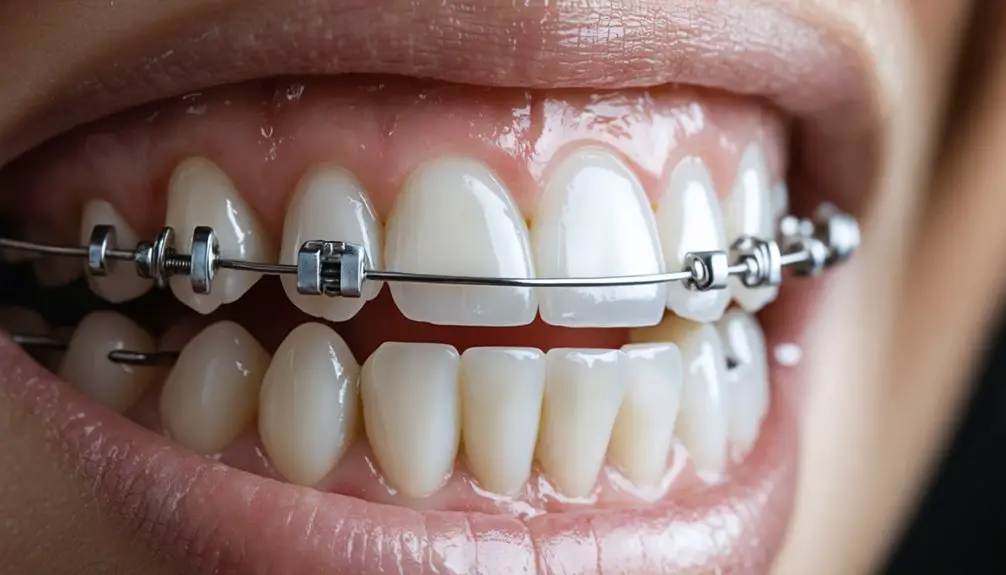
While undergoing orthodontic treatment, protecting your teeth against enamel demineralization becomes essential to prevent white spot lesions and maintain ideal oral health.
You’ll need regular fluoride treatments to strengthen your teeth, as fluoride converts hydroxide ions into acid-resistant fluorapatite. High-concentration fluoride varnishes (up to 22,000 ppm) provide superior enamel remineralization, especially when combined with calcium-phosphate compounds.
Apply protective sealants before bracket placement to create barriers against plaque accumulation.
Limit your exposure to acidic foods and beverages while increasing consumption of calcium-rich products to support natural remineralization. Use orthodontic-specific brushes and interdental cleaners to remove plaque effectively.
Consider incorporating antibacterial mouth rinses to reduce harmful bacteria. These preventive measures will greatly decrease your risk of developing permanent enamel damage during orthodontic treatment.
Use Appropriate Whitening Products
When choosing toothpaste while wearing braces, select products specifically formulated for orthodontic use that contain fluoride and gentle whitening agents.
You’ll need to consult your orthodontist before starting any whitening treatment to guarantee it’s compatible with your brackets and won’t compromise your ongoing orthodontic care.
Your orthodontist can recommend braces-safe whitening products that contain appropriate concentrations of peroxide and sensitivity-reducing ingredients like potassium nitrate.
Choose Whitening-Safe Toothpaste
Selecting the right whitening toothpaste for braces requires careful consideration of specific ingredients and formulations to protect both your orthodontic appliances and tooth enamel.
Look for fluoride-containing products that are specifically labeled as non-abrasive and safe for orthodontic use. You’ll want to avoid toothpaste ingredients like charcoal or baking soda that can damage brackets and adhesives.
For ideal whitening effectiveness, choose ADA-approved options like Colgate Total Whitening or Sensodyne Pronamel Gentle Whitening toothpaste. These formulations use gentle polishing agents to remove surface stains while protecting your orthodontic investment.
Remember that whitening toothpaste can only affect exposed tooth surfaces, not areas under brackets, so maintaining consistent oral hygiene is essential to prevent uneven discoloration during your orthodontic treatment.
Consult Orthodontist Before Whitening
Before attempting any teeth whitening with braces, consulting your orthodontist is essential to prevent potential damage to your orthodontic appliances and secure ideal results.
Your orthodontist will perform a thorough orthodontic assessment to evaluate your oral health status and determine if whitening is appropriate during your treatment.
They’ll consider your braces type, alignment progress, and gum health to establish the safest timing for whitening procedures.
Through professional guidance, you’ll receive customized recommendations for whitening safety, including proper product selection and application methods.
Your orthodontist can prescribe the right concentration of whitening agents and make certain treatments don’t interfere with scheduled adjustments or bonding materials.
They’ll also monitor your progress to quickly address any sensitivity or uneven whitening issues that may arise during the process.
Maintain Proper Hydration
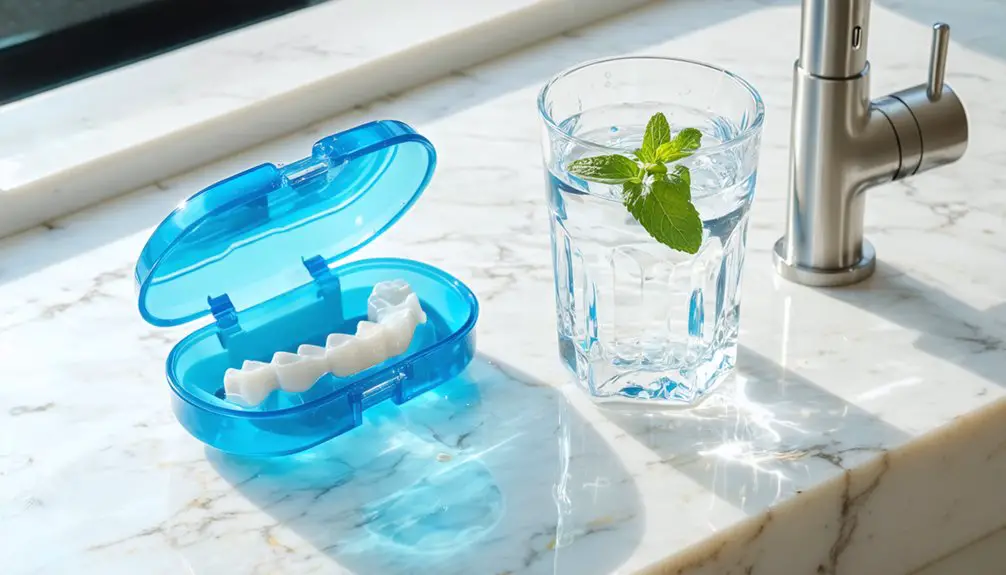
Proper hydration plays an essential role in maximizing the effectiveness of teeth whitening while wearing braces. The hydration benefits extend beyond basic wellness, as adequate water intake stimulates saliva production, which naturally cleanses your teeth and protects the enamel during whitening treatments.
You’ll need to maintain consistent hydration throughout your whitening process, as it helps prevent tooth dehydration that can lead to sensitivity and temporary color instability.
Your increased saliva flow will help neutralize acids, dilute staining agents, and protect against white spot lesions around your brackets. To optimize your results, drink water regularly during meals and throughout the day. This practice helps rinse away potential staining compounds while supporting the natural cleansing mechanisms that keep your teeth and orthodontic appliances clean.
Follow Professional Dental Guidance
While pursuing teeth whitening with braces, professional dental guidance becomes paramount for achieving ideal results and preventing complications. Your dental provider will perform thorough assessments to evaluate your oral health, enamel thickness, and sensitivity levels before recommending appropriate whitening options.
Follow your dentist’s professional recommendations regarding treatment timing and product selection. They’ll determine whether you should wait until after braces removal or use specialized whitening products designed for orthodontic patients.
Your provider will monitor the process closely, ensuring proper application techniques and protecting your soft tissues from irritation. They’ll also adjust treatment parameters if you experience sensitivity.
Regular dental check-ups during and after whitening help maintain excellent results while safeguarding your enamel integrity. Your dentist will guide you on post-treatment care and recommend specific products for long-term maintenance.
Address Discoloration Issues Promptly
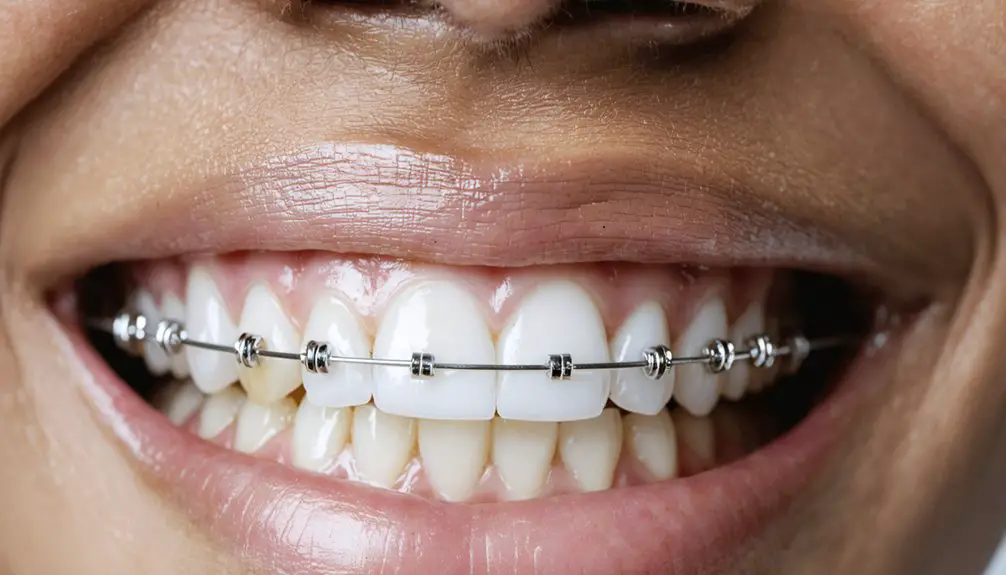
Maintaining vigilant observation of your teeth during orthodontic treatment enables early detection and prevention of discoloration issues.
Understanding discoloration causes and implementing preventive measures promptly can protect your smile’s appearance during orthodontic care.
Monitor your teeth daily for signs of plaque accumulation or staining around brackets, and address concerns immediately through enhanced cleaning techniques and professional guidance.
- Inspect your teeth after each cleaning session for any remaining plaque or visible stains
- Document any white spots or changes in enamel appearance for discussion with your orthodontist
- Increase cleaning frequency if you notice early signs of discoloration
- Request professional cleaning when you observe stubborn plaque buildup
- Adjust your dietary choices immediately if you notice staining from certain foods or beverages
Frequently Asked Questions
Can I Use Whitening Strips on Areas of Teeth Not Covered by Brackets?
You shouldn’t use whitening strips with braces, as they’ll create uneven coloring and compromise braces maintenance. For whitening safety, wait until your orthodontic treatment’s complete or consult your orthodontist for alternatives.
How Soon After Braces Removal Should I Wait Before Professional Whitening Treatment?
You’ll need to wait at least one month, but ideally six months, for proper post-braces care and best whitening timeline. This allows your teeth to stabilize and guarantees even, lasting results.
Will Insurance Cover Teeth Whitening Procedures After Orthodontic Treatment?
Most insurance policies won’t cover whitening costs after braces since it’s considered cosmetic. You’ll likely need to pay out-of-pocket, though some employer plans offer limited coverage with specific restrictions.
Do Ceramic or Clear Braces Stain More Easily Than Metal Ones?
Yes, your ceramic braces will stain more readily than metal ones. While the ceramic material offers good stain resistance, the clear elastics and adhesives are particularly susceptible to discoloration from dark foods and drinks.
Can Teeth Naturally Whiten While Wearing Braces Without Any Special Treatments?
Want the truth about natural whitening with braces? You won’t see significant whitening without treatment. Your teeth can’t lighten naturally under brackets, and proper braces maintenance only prevents further staining.
References
- https://www.webmd.com/oral-health/whiten-teeth-wearing-braces
- https://imageorthodontics.com/can-you-whiten-your-teeth-with-braces/
- https://nowlinortho.com/blog/5-tips-for-whitening-teeth-with-braces/
- https://oralb.com/en-us/oral-health/life-stages/kids/how-to-whiten-teeth-with-braces/
- https://www.healthline.com/health/whitening-with-braces
- https://luvmyorthodontist.com/teeth-whitening-after-braces/
- https://nycteethwhiteningservice.com/the-radiant-smile-benefits-of-professional-laser-teeth-whitening-after-braces/
- https://www.salmoncreekdentistry.com/blog/professional-teeth-whitening-after-braces-achieving-a-brighter-smile/
- https://abqteethwhitening.com/why-you-should-consider-laser-teeth-whitening-after-braces/
- https://orthodonticassoc.com/braces/benefits-to-post-braces-tooth-whitening/
